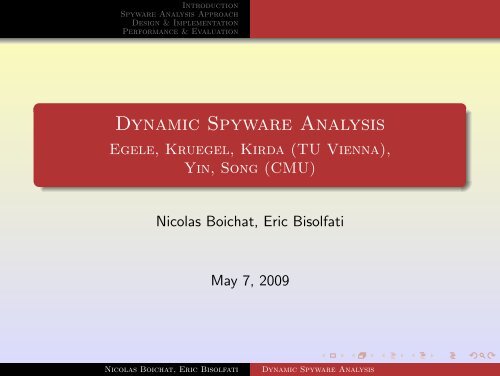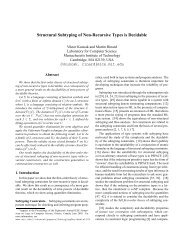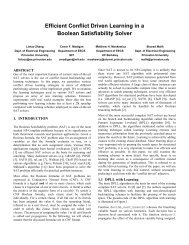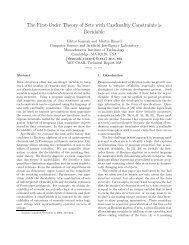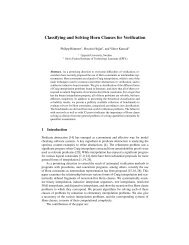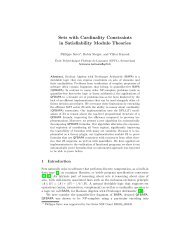Dynamic Spyware Analysis - Egele, Kruegel, Kirda ... - LARA - EPFL
Dynamic Spyware Analysis - Egele, Kruegel, Kirda ... - LARA - EPFL
Dynamic Spyware Analysis - Egele, Kruegel, Kirda ... - LARA - EPFL
You also want an ePaper? Increase the reach of your titles
YUMPU automatically turns print PDFs into web optimized ePapers that Google loves.
Introduction<br />
<strong>Spyware</strong> <strong>Analysis</strong> Approach<br />
Design & Implementation<br />
Performance & Evaluation<br />
<strong>Dynamic</strong> <strong>Spyware</strong> <strong>Analysis</strong><br />
<strong>Egele</strong>, <strong>Kruegel</strong>, <strong>Kirda</strong> (TU Vienna),<br />
Yin, Song (CMU)<br />
Nicolas Boichat, Eric Bisolfati<br />
May 7, 2009<br />
Nicolas Boichat, Eric Bisolfati <strong>Dynamic</strong> <strong>Spyware</strong> <strong>Analysis</strong>
Outline<br />
1 Introduction<br />
Introduction<br />
<strong>Spyware</strong> <strong>Analysis</strong> Approach<br />
Design & Implementation<br />
Performance & Evaluation<br />
2 <strong>Spyware</strong> <strong>Analysis</strong> Approach<br />
3 Design & Implementation<br />
System Overview<br />
Taint propagation<br />
Operating System Awareness<br />
4 Performance & Evaluation<br />
Performance<br />
Evaluation<br />
Conclusion<br />
Nicolas Boichat, Eric Bisolfati <strong>Dynamic</strong> <strong>Spyware</strong> <strong>Analysis</strong>
Introduction<br />
<strong>Spyware</strong> <strong>Analysis</strong> Approach<br />
Design & Implementation<br />
Performance & Evaluation<br />
Introducing the terminology - <strong>Spyware</strong><br />
<strong>Spyware</strong>: Malicious code installed on victim’s machine:<br />
Monitors the behaviour of users (URL visited, passwords...)<br />
Leaks the data back to the attacker (saved to disk, sent over<br />
the network)<br />
Nicolas Boichat, Eric Bisolfati <strong>Dynamic</strong> <strong>Spyware</strong> <strong>Analysis</strong>
Introduction<br />
<strong>Spyware</strong> <strong>Analysis</strong> Approach<br />
Design & Implementation<br />
Performance & Evaluation<br />
Introducing the terminology - BHO<br />
Browser Helper Objects (BHO):<br />
DLL loaded by Internet Explorer (share its address space)<br />
Normally provide extensions to IE (pop-up blocking, mouse<br />
gestures...)<br />
Also used by about 75% of spywares<br />
Nicolas Boichat, Eric Bisolfati <strong>Dynamic</strong> <strong>Spyware</strong> <strong>Analysis</strong>
Introduction<br />
<strong>Spyware</strong> <strong>Analysis</strong> Approach<br />
Design & Implementation<br />
Performance & Evaluation<br />
<strong>Spyware</strong> <strong>Analysis</strong> Approach<br />
Common practise:<br />
Goal:<br />
Detection through signature detection<br />
→ Database must be kept up-to-date<br />
→ Difficulty to deal with obfuscation<br />
<strong>Dynamic</strong> analysis<br />
Static analysis<br />
Determine which sensitive data is leaked and where it is sent<br />
Nicolas Boichat, Eric Bisolfati <strong>Dynamic</strong> <strong>Spyware</strong> <strong>Analysis</strong>
Introduction<br />
<strong>Spyware</strong> <strong>Analysis</strong> Approach<br />
Design & Implementation<br />
Performance & Evaluation<br />
<strong>Spyware</strong> <strong>Analysis</strong> Approach<br />
3 complementary approaches:<br />
<strong>Dynamic</strong> Taint <strong>Analysis</strong>: Sensitive data is tainted<br />
→ <strong>Dynamic</strong> analysis<br />
Operating System Awareness: Distinguish between actions<br />
performed by IE and by BHO<br />
Browser session Recording and Replaying: IE visits a large<br />
number of pages (test coverage)<br />
→ <strong>Spyware</strong> will trigger and reveal its malicious behaviour<br />
Nicolas Boichat, Eric Bisolfati <strong>Dynamic</strong> <strong>Spyware</strong> <strong>Analysis</strong>
Introduction<br />
<strong>Spyware</strong> <strong>Analysis</strong> Approach<br />
Design & Implementation<br />
Performance & Evaluation<br />
<strong>Spyware</strong> <strong>Analysis</strong> Approach<br />
3 complementary approaches:<br />
<strong>Dynamic</strong> Taint <strong>Analysis</strong>: Sensitive data is tainted<br />
→ <strong>Dynamic</strong> analysis<br />
Operating System Awareness: Distinguish between actions<br />
performed by IE and by BHO<br />
Browser session Recording and Replaying: IE visits a large<br />
number of pages (test coverage)<br />
→ <strong>Spyware</strong> will trigger and reveal its malicious behaviour<br />
Nicolas Boichat, Eric Bisolfati <strong>Dynamic</strong> <strong>Spyware</strong> <strong>Analysis</strong>
Introduction<br />
<strong>Spyware</strong> <strong>Analysis</strong> Approach<br />
Design & Implementation<br />
Performance & Evaluation<br />
System Overview<br />
<strong>Dynamic</strong> taint analysis:<br />
System Overview<br />
Taint propagation<br />
Operating System Awareness<br />
Built on top of QEMU (assembly code analysis)<br />
Sensitive data marked as tainted, and tracked through the<br />
browser and BHO<br />
If tainted information is leaked by BHO outside the address<br />
space of the browser:<br />
→ malicious flow<br />
If leaked by IE:<br />
→ “benign” flow (history tracking, saving in cache...)<br />
Nicolas Boichat, Eric Bisolfati <strong>Dynamic</strong> <strong>Spyware</strong> <strong>Analysis</strong>
Introduction<br />
<strong>Spyware</strong> <strong>Analysis</strong> Approach<br />
Design & Implementation<br />
Performance & Evaluation<br />
System overview<br />
System Overview<br />
Taint propagation<br />
Operating System Awareness<br />
Figure: System overview<br />
Nicolas Boichat, Eric Bisolfati <strong>Dynamic</strong> <strong>Spyware</strong> <strong>Analysis</strong>
Introduction<br />
<strong>Spyware</strong> <strong>Analysis</strong> Approach<br />
Design & Implementation<br />
Performance & Evaluation<br />
<strong>Dynamic</strong> taint propagation<br />
System Overview<br />
Taint propagation<br />
Operating System Awareness<br />
Taint propagation (data dependencies):<br />
All output bytes of an operation marked as tainted<br />
whenever:<br />
any input operand is tainted<br />
the register containing the memory address to access is<br />
tainted<br />
Shadow memory:<br />
Keep track of the taint status of all bytes in memory (+ GP<br />
registers)<br />
One byte per byte of memory<br />
→ allows to track which information the data in memory<br />
depends on<br />
Nicolas Boichat, Eric Bisolfati <strong>Dynamic</strong> <strong>Spyware</strong> <strong>Analysis</strong>
Introduction<br />
<strong>Spyware</strong> <strong>Analysis</strong> Approach<br />
Design & Implementation<br />
Performance & Evaluation<br />
<strong>Dynamic</strong> taint propagation<br />
System Overview<br />
Taint propagation<br />
Operating System Awareness<br />
Taint propagation (data dependencies):<br />
All output bytes of an operation marked as tainted<br />
whenever:<br />
any input operand is tainted<br />
the register containing the memory address to access is<br />
tainted<br />
Shadow memory:<br />
Keep track of the taint status of all bytes in memory (+ GP<br />
registers)<br />
One byte per byte of memory<br />
→ allows to track which information the data in memory<br />
depends on<br />
However, detection is easy to evade... Can someone see how?<br />
Nicolas Boichat, Eric Bisolfati <strong>Dynamic</strong> <strong>Spyware</strong> <strong>Analysis</strong>
Introduction<br />
<strong>Spyware</strong> <strong>Analysis</strong> Approach<br />
Design & Implementation<br />
Performance & Evaluation<br />
System Overview<br />
Taint propagation<br />
Operating System Awareness<br />
evading detection of data dependencies<br />
Consider that t contains some sensitive data:<br />
The is no direct data dependency between t and plop<br />
→ value plop will not be tainted<br />
Nicolas Boichat, Eric Bisolfati <strong>Dynamic</strong> <strong>Spyware</strong> <strong>Analysis</strong>
Introduction<br />
<strong>Spyware</strong> <strong>Analysis</strong> Approach<br />
Design & Implementation<br />
Performance & Evaluation<br />
System Overview<br />
Taint propagation<br />
Operating System Awareness<br />
Solution: Direct Control Dependencies<br />
Solution:<br />
Handle control dependencies<br />
If the execution of an instruction depends on a tainted<br />
variable<br />
→ the output of the instruction is tainted<br />
Nicolas Boichat, Eric Bisolfati <strong>Dynamic</strong> <strong>Spyware</strong> <strong>Analysis</strong>
Introduction<br />
<strong>Spyware</strong> <strong>Analysis</strong> Approach<br />
Design & Implementation<br />
Performance & Evaluation<br />
System Overview<br />
Taint propagation<br />
Operating System Awareness<br />
Direct Control Dependencies Handling<br />
To handle control dependencies:<br />
The taint engine examines all encountered conditional<br />
branch instructions during execution<br />
If the branch condition depends on a tainted value<br />
→ identify all instructions conditionally dependent on the<br />
result of the branch, using static analysis<br />
Nicolas Boichat, Eric Bisolfati <strong>Dynamic</strong> <strong>Spyware</strong> <strong>Analysis</strong>
Post-dominator<br />
Introduction<br />
<strong>Spyware</strong> <strong>Analysis</strong> Approach<br />
Design & Implementation<br />
Performance & Evaluation<br />
System Overview<br />
Taint propagation<br />
Operating System Awareness<br />
Find the post-dominators of the branch instruction.<br />
(i.e. the instructions that will be executed whether the<br />
condition is true or false)<br />
Continue the execution, and taint all outputs until a<br />
post-dominator is reached<br />
Nicolas Boichat, Eric Bisolfati <strong>Dynamic</strong> <strong>Spyware</strong> <strong>Analysis</strong>
Untainting<br />
Introduction<br />
<strong>Spyware</strong> <strong>Analysis</strong> Approach<br />
Design & Implementation<br />
Performance & Evaluation<br />
System Overview<br />
Taint propagation<br />
Operating System Awareness<br />
Untainting:<br />
Tainting is erased when the register or memory location is<br />
overwritten:<br />
movb %eax, 0x8 : constants untainted<br />
Can be tricky on x86:<br />
xor %eax, %eax : zeroing %eax<br />
Others cryptic ways to zero a value (with subs, etc...)<br />
Nicolas Boichat, Eric Bisolfati <strong>Dynamic</strong> <strong>Spyware</strong> <strong>Analysis</strong>
Introduction<br />
<strong>Spyware</strong> <strong>Analysis</strong> Approach<br />
Design & Implementation<br />
Performance & Evaluation<br />
Operating System Awareness<br />
Whole operating system running<br />
System Overview<br />
Taint propagation<br />
Operating System Awareness<br />
Need to identify when IE is active<br />
→ Hooks in operating system<br />
→ Uses page table physical address as an identifier<br />
And where BHO is loaded in IE address space<br />
Nicolas Boichat, Eric Bisolfati <strong>Dynamic</strong> <strong>Spyware</strong> <strong>Analysis</strong>
Introduction<br />
<strong>Spyware</strong> <strong>Analysis</strong> Approach<br />
Design & Implementation<br />
Performance & Evaluation<br />
System Overview<br />
Taint propagation<br />
Operating System Awareness<br />
Operating System Awareness - BHO<br />
To know if an operation is initiated by BHO:<br />
When execution passes from IE to BHO<br />
→ save the stack pointer.<br />
As long as the stack pointer is below that<br />
value → flow initiated by BHO.<br />
These outputs marked as “suspicious”<br />
→ if data is leaked<br />
→ malicious flow<br />
Nicolas Boichat, Eric Bisolfati <strong>Dynamic</strong> <strong>Spyware</strong> <strong>Analysis</strong>
Performance<br />
Introduction<br />
<strong>Spyware</strong> <strong>Analysis</strong> Approach<br />
Design & Implementation<br />
Performance & Evaluation<br />
Performance<br />
Evaluation<br />
Conclusion<br />
Static analysis used only in BHO (IE assumed sane)<br />
Avoids taint label explosion<br />
Still relatively slow, but can be used by analysts<br />
Min Max Average<br />
Native Windows 0.6 2.9 1.9<br />
QEMU 1.8 6.1 3.6<br />
Modified QEMU 17.3 79.4 35.7<br />
Table: Page loading times<br />
Nicolas Boichat, Eric Bisolfati <strong>Dynamic</strong> <strong>Spyware</strong> <strong>Analysis</strong>
Evaluation<br />
Introduction<br />
<strong>Spyware</strong> <strong>Analysis</strong> Approach<br />
Design & Implementation<br />
Performance & Evaluation<br />
Performance<br />
Evaluation<br />
Conclusion<br />
Various spywares/benign BHO tested:<br />
All spyware correctly classified<br />
All but 2 benign BHO correctly classified<br />
<strong>Spyware</strong> FN Benign Suspicious FP<br />
<strong>Spyware</strong> 21 0 - - -<br />
Benign - - 12 1 1<br />
Table: <strong>Spyware</strong>/benign BHO analysis<br />
Nicolas Boichat, Eric Bisolfati <strong>Dynamic</strong> <strong>Spyware</strong> <strong>Analysis</strong>
Introduction<br />
<strong>Spyware</strong> <strong>Analysis</strong> Approach<br />
Design & Implementation<br />
Performance & Evaluation<br />
Performance<br />
Evaluation<br />
Conclusion<br />
Evaluation - False positive<br />
PrivacyBird BHO:<br />
Privacy management standard implementation.<br />
Retrieves a privacy policy (http://website/w3c/p3p.xml)<br />
Nicolas Boichat, Eric Bisolfati <strong>Dynamic</strong> <strong>Spyware</strong> <strong>Analysis</strong>
Introduction<br />
<strong>Spyware</strong> <strong>Analysis</strong> Approach<br />
Design & Implementation<br />
Performance & Evaluation<br />
Performance<br />
Evaluation<br />
Conclusion<br />
Evaluation - False positive<br />
PrivacyBird BHO:<br />
Example:<br />
Privacy management standard implementation.<br />
Retrieves a privacy policy (http://website/w3c/p3p.xml)<br />
When http://www.epfl.ch/ is accessed.<br />
BHO accesses http://www.epfl.ch/w3c/p3p.xml<br />
Nicolas Boichat, Eric Bisolfati <strong>Dynamic</strong> <strong>Spyware</strong> <strong>Analysis</strong>
Introduction<br />
<strong>Spyware</strong> <strong>Analysis</strong> Approach<br />
Design & Implementation<br />
Performance & Evaluation<br />
Performance<br />
Evaluation<br />
Conclusion<br />
Evaluation - False positive<br />
PrivacyBird BHO:<br />
Example:<br />
Privacy management standard implementation.<br />
Retrieves a privacy policy (http://website/w3c/p3p.xml)<br />
When http://www.epfl.ch/ is accessed.<br />
BHO accesses http://www.epfl.ch/w3c/p3p.xml<br />
URL is leaked!<br />
Nicolas Boichat, Eric Bisolfati <strong>Dynamic</strong> <strong>Spyware</strong> <strong>Analysis</strong>
Introduction<br />
<strong>Spyware</strong> <strong>Analysis</strong> Approach<br />
Design & Implementation<br />
Performance & Evaluation<br />
Performance<br />
Evaluation<br />
Conclusion<br />
Evaluation - False positive<br />
PrivacyBird BHO:<br />
Example:<br />
Privacy management standard implementation.<br />
Retrieves a privacy policy (http://website/w3c/p3p.xml)<br />
When http://www.epfl.ch/ is accessed.<br />
BHO accesses http://www.epfl.ch/w3c/p3p.xml<br />
URL is leaked!<br />
But the information is not sent to the attacker!<br />
→ false positive<br />
Nicolas Boichat, Eric Bisolfati <strong>Dynamic</strong> <strong>Spyware</strong> <strong>Analysis</strong>
Introduction<br />
<strong>Spyware</strong> <strong>Analysis</strong> Approach<br />
Design & Implementation<br />
Performance & Evaluation<br />
Performance<br />
Evaluation<br />
Conclusion<br />
Evaluation - Suspicious Sample<br />
LostGoggles BHO:<br />
Adds images to Google search<br />
Downloads a JavaScript locally, then embeds it in the Google<br />
search<br />
Nicolas Boichat, Eric Bisolfati <strong>Dynamic</strong> <strong>Spyware</strong> <strong>Analysis</strong>
Introduction<br />
<strong>Spyware</strong> <strong>Analysis</strong> Approach<br />
Design & Implementation<br />
Performance & Evaluation<br />
Performance<br />
Evaluation<br />
Conclusion<br />
Evaluation - Suspicious Sample<br />
LostGoggles BHO:<br />
Adds images to Google search<br />
Downloads a JavaScript locally, then embeds it in the Google<br />
search<br />
Problem:<br />
During the first access to Google, downloads the JavaScript.<br />
In the request, the Referer field is set!<br />
HTTP Request:<br />
GET /script/LostGoggles.js HTTP/1.1<br />
...<br />
Referer: http://www.google.ch/search?q=SAV+what+a+fun+course<br />
Nicolas Boichat, Eric Bisolfati <strong>Dynamic</strong> <strong>Spyware</strong> <strong>Analysis</strong>
Introduction<br />
<strong>Spyware</strong> <strong>Analysis</strong> Approach<br />
Design & Implementation<br />
Performance & Evaluation<br />
Performance<br />
Evaluation<br />
Conclusion<br />
Evaluation - Suspicious Sample<br />
LostGoggles BHO:<br />
Adds images to Google search<br />
Downloads a JavaScript locally, then embeds it in the Google<br />
search<br />
Problem:<br />
During the first access to Google, downloads the JavaScript.<br />
In the request, the Referer field is set!<br />
→ information leak (probably unintended).<br />
HTTP Request:<br />
GET /script/LostGoggles.js HTTP/1.1<br />
...<br />
Referer: http://www.google.ch/search?q=SAV+what+a+fun+course<br />
Nicolas Boichat, Eric Bisolfati <strong>Dynamic</strong> <strong>Spyware</strong> <strong>Analysis</strong>
Conclusion<br />
Introduction<br />
<strong>Spyware</strong> <strong>Analysis</strong> Approach<br />
Design & Implementation<br />
Performance & Evaluation<br />
<strong>Dynamic</strong> spyware analysis<br />
Performance<br />
Evaluation<br />
Conclusion<br />
Switch to static analysis for control dependencies<br />
Detailed reports about which sensitive data is leaked and<br />
where it is sent<br />
Nicolas Boichat, Eric Bisolfati <strong>Dynamic</strong> <strong>Spyware</strong> <strong>Analysis</strong>
Introduction<br />
<strong>Spyware</strong> <strong>Analysis</strong> Approach<br />
Design & Implementation<br />
Performance & Evaluation<br />
Performance<br />
Evaluation<br />
Conclusion<br />
Thanks for your attention<br />
Questions ?<br />
Nicolas Boichat, Eric Bisolfati <strong>Dynamic</strong> <strong>Spyware</strong> <strong>Analysis</strong>


